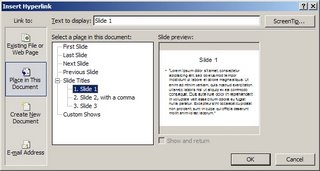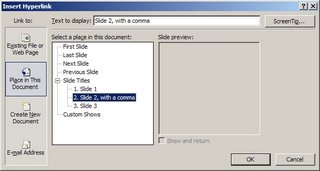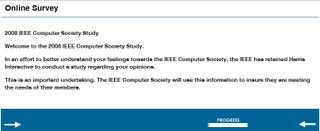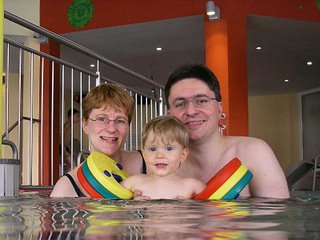Random thoughts
Thursday, April 24, 2008
PowerPoint: No comma, please
A colleague recently showed me a strange problem with Microsoft Office: When inserting a hyperlink in a PowerPoint presentation, one of the available options is linking to another page in the same document:

This seemed to work nicely for most slides but not for the particular slide he was trying to link to, and PowerPoint would not even show a preview in the hyperlink dialog box:

The programmer in me quickly scanned through the slide looking for “suspicious” elements, the only thing that caught my attention though was an innocent looking comma.
Turns out the comma is indeed the culprit, and the bug is well-documented in the Microsoft knowledge base: The hyperlink to a slide does not work when a comma is contained in the title of a slide presentation in PowerPoint.
Removing the comma, placing the hyperlink and then adding the comma back does seem to do the trick. Or, just don't use a comma.

This seemed to work nicely for most slides but not for the particular slide he was trying to link to, and PowerPoint would not even show a preview in the hyperlink dialog box:

The programmer in me quickly scanned through the slide looking for “suspicious” elements, the only thing that caught my attention though was an innocent looking comma.
Turns out the comma is indeed the culprit, and the bug is well-documented in the Microsoft knowledge base: The hyperlink to a slide does not work when a comma is contained in the title of a slide presentation in PowerPoint.
Removing the comma, placing the hyperlink and then adding the comma back does seem to do the trick. Or, just don't use a comma.
Labels: technology, windows
Saturday, April 19, 2008
Usability: When forward goes backward
The IEEE Computer Society recently invited members to participate in a survey. Admittedly, since taking on my current job I have developed a strange desire for taking surveys to see what others are doing and what we could learn from them.
Besides being too long (read: I stopped answering the survey once I figured this would take me longer than I was willing to click through question after question) this particular survey had an interesting usability problem: For some reason, the forward link to move to the next question is on the left, whereas the backward link is on the right:

The designer may have considered reading order or attempted to make the site more accessible by putting the more frequently used option first, which would be commendable, but the result is a poor navigation scheme. I would be curious to know how many respondents get frustrated about this and abandon the survey.
Besides being too long (read: I stopped answering the survey once I figured this would take me longer than I was willing to click through question after question) this particular survey had an interesting usability problem: For some reason, the forward link to move to the next question is on the left, whereas the backward link is on the right:

The designer may have considered reading order or attempted to make the site more accessible by putting the more frequently used option first, which would be commendable, but the result is a poor navigation scheme. I would be curious to know how many respondents get frustrated about this and abandon the survey.
Labels: usability
Friday, April 18, 2008
VPS, PDC, DVB, EPG—Why can VCRs not just work?
Video cassette recorders (VCR) have a long-standing reputation for being difficult to use (searching for VCR and usability returns some 90,000 results on Google).
In the early days setting the timer right may have been challenging, and too often the program would change or fall behind and the tape would contain a different program, or a cut off film. Then came the Video Programming System (VPS) and ShowView, which made programming VCRs easy and greatly increased the likelihood of recording the desired program, and later Programme Delivery Control (PDC).
Everything seemed fine until last year when a decision was made to discontinue analog TV broadcasting in Austria and switching to Digial Video Broadcasting (DVB-T). The television system had maintained backwards compatibility with the great many enhancements over the years, from black-and-white to color, from mono to stereo and dual channel audio. This time, however, new equipment would be needed in the form of DVB-T receivers, and of course that means one for each TV set and recorder.
Our first attempt with a twin receiver bought on EBay was a dismal failure. The device seemed malfunctioning and vendor support was non-existent (more precisely, we were unable to locate the vendor, which seemed to have gone out of business). We happily lived for a few weeks without television.
Eventually we got a nice Sony HXD-870 HD/DVD recorder with built-in DVB-T tuner and at first were quite happy. Setting up the device was easy (except for the fact it did not recognize Austria as a country) and we were back to receiving and recording TV programs.
Although the new recorder supports VPS/PDC it does so only from analog sources, which are no longer available, but not from the digital signal despite the fact that the VPS signal is sent digitally as well. The new Electronic Program Guide (EPG) is convenient, but there is no way to tell the recorder to start when the program starts. Instead you can manually tweak the time range to increase the likelihood of recording the full program.
If that wasn't bad enough already, when we switched to daylight savings time, or summer time as it's called here, the program guide appeared to be off by one hour and so were all recordings. There is a timezone menu but toggling daylight savings time on and off did not seem to make any difference.
The Sony support Website was less than helpful. The only firmware upgrade was for the UK version of the recorder and fixed an unrelated problem that we hadn't encountered.
Fortunately a kind soul owning the same device came to rescue and shared instructions how to overcome this bug by switching to a different time zone and then rebooting the recorder. We have since been running on Helsinki time and had mixed success in recording programs.
With all the advances in technology and three-letter acronym features, we are essentially back to the functionality in the early days of video recording, manually setting times and hoping for the program to stay on schedule.
Why can VCRs not just work?
In the early days setting the timer right may have been challenging, and too often the program would change or fall behind and the tape would contain a different program, or a cut off film. Then came the Video Programming System (VPS) and ShowView, which made programming VCRs easy and greatly increased the likelihood of recording the desired program, and later Programme Delivery Control (PDC).
Everything seemed fine until last year when a decision was made to discontinue analog TV broadcasting in Austria and switching to Digial Video Broadcasting (DVB-T). The television system had maintained backwards compatibility with the great many enhancements over the years, from black-and-white to color, from mono to stereo and dual channel audio. This time, however, new equipment would be needed in the form of DVB-T receivers, and of course that means one for each TV set and recorder.
Our first attempt with a twin receiver bought on EBay was a dismal failure. The device seemed malfunctioning and vendor support was non-existent (more precisely, we were unable to locate the vendor, which seemed to have gone out of business). We happily lived for a few weeks without television.
Eventually we got a nice Sony HXD-870 HD/DVD recorder with built-in DVB-T tuner and at first were quite happy. Setting up the device was easy (except for the fact it did not recognize Austria as a country) and we were back to receiving and recording TV programs.
Although the new recorder supports VPS/PDC it does so only from analog sources, which are no longer available, but not from the digital signal despite the fact that the VPS signal is sent digitally as well. The new Electronic Program Guide (EPG) is convenient, but there is no way to tell the recorder to start when the program starts. Instead you can manually tweak the time range to increase the likelihood of recording the full program.
If that wasn't bad enough already, when we switched to daylight savings time, or summer time as it's called here, the program guide appeared to be off by one hour and so were all recordings. There is a timezone menu but toggling daylight savings time on and off did not seem to make any difference.
The Sony support Website was less than helpful. The only firmware upgrade was for the UK version of the recorder and fixed an unrelated problem that we hadn't encountered.
Fortunately a kind soul owning the same device came to rescue and shared instructions how to overcome this bug by switching to a different time zone and then rebooting the recorder. We have since been running on Helsinki time and had mixed success in recording programs.
With all the advances in technology and three-letter acronym features, we are essentially back to the functionality in the early days of video recording, manually setting times and hoping for the program to stay on schedule.
Why can VCRs not just work?
Labels: technology, usability
Tuesday, April 15, 2008
Back from vacation
We just returned from a few relaxing days at Reiter's Burgenlandresort in Bad Tatzmannsdorf.

This is the second time we stayed at this hotel, and we had a great time again. Elias enjoyed the many opportunities for playing, sliding and swimming, and the hotel even offered introductory Tai Chi lessons (as I found out afterwards, a different Tai Chi style from the one we learn, which would explain why moves by the same names would feel different).

This is the second time we stayed at this hotel, and we had a great time again. Elias enjoyed the many opportunities for playing, sliding and swimming, and the hotel even offered introductory Tai Chi lessons (as I found out afterwards, a different Tai Chi style from the one we learn, which would explain why moves by the same names would feel different).
Labels: personal